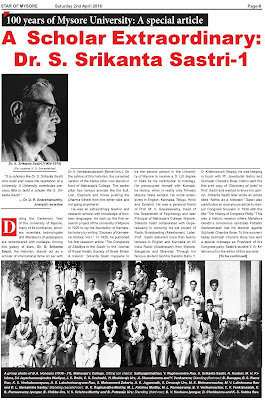Holenarsipur Yoganarasimham Sharada Prasad (H. Y. Sharada Prasad) was a well known freedom fighter, journalist, translator and a press information advisor to four Indian Prime Ministers – Pt. Jawaharlal Nehru (H. Y. S was editing ‘Yojana’ - a Government of India publication at that time), Mrs. Indira Gandhi, Sri Moraji Desai and Rajiv Gandhi. He was born on 15th of April, 1924 to Sri H. Yoganarasimham and Smt. Saraswathamma. His father was an erudite Sanskrit scholar and a musicologist. Mother was a well known social worker who was one of the founders of “Makkala Koota” at Bangalore & Mysore.
H. Y. Sharada Prasad came into prominence during his B. A. (Hons.) student days at Maharaja College, Mysore. He was a brilliant student of English Literature and a debater. He was also president of the student union. He was taught by such eminent professors as J. C. Rollo, S. Srikanta Sastri and A. N. Murthy Rao. As a student leader, he was deeply involved in the 1942 Quit India movement. He was arrested and jailed in Mysore & Bangalore prisons twice during his college days. He spent totally sixteen months in jail from 10 August, 1942 to December 1942 and from 20 February, 1943 to 9 December 1943. In his prison diary (A Window on the Wall), he has narrated his encounters with other great leaders and the depressing atmosphere of an Indian prison. His B. A. (Hons.) education was resumed after he was released from jail. H. Y. Sharada Prasad later got married to Smt. Kamalamma – a contemporary of his while at Maharaja’s College, Mysore and a honours graduate in Psychology.
H. Y. Sharada Prasad who was called ‘Shouri’ by near and dear ones left for Bombay to pursue a career in Journalism in ‘The Indian Express Group’. During 1955 – 56, he was ‘Nieman Fellow’ in Journalism at Harvard University. After this stint, he moved on to New Delhi to take up the post of Assistant Editor of ‘Yojana’ – a journal of Planning Commission of India. During this period, by organizing an exhibition on India’s Economic Development, he caught the attention of Prime Minister Nehru. Later, Prime Minister Indira Gandhi invited him to join PMO as an Information Adviser. After Emergency, when Morarji Desai became Prime Minister, he continued to hold his post despite a sea of change in the PMO. After the return of Mrs. Gandhi to power in 1980, Shouri continued to be her confidante counselor. When Rajiv Gandhi became PM after his mother’s assassination, Shouri continued to serve him for some time. Sharada Prasad was instrumental in the establishment of The Indian Institute of Mass Communication and The National Institute of Design. His close proximity to the powerful personalities did not alter his character. He remained humble, modest and simple as ever.
For the rest of the article, Click Here















